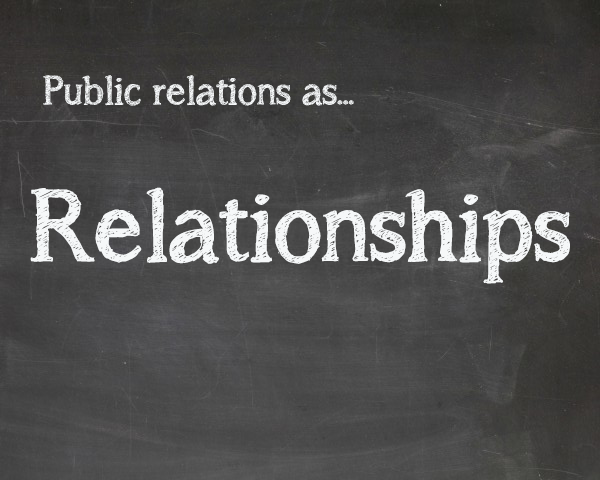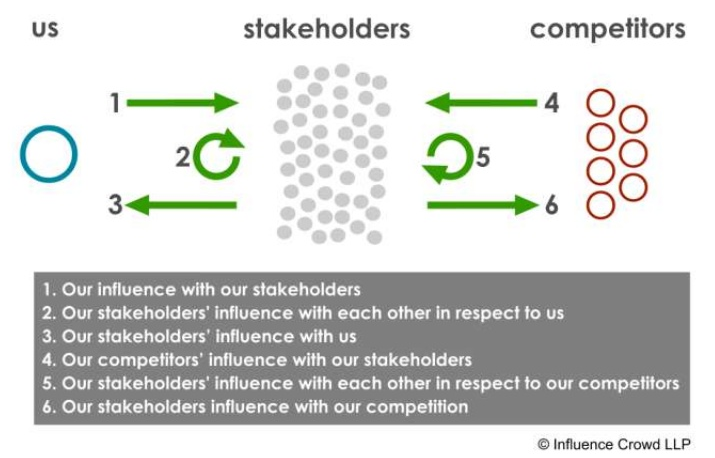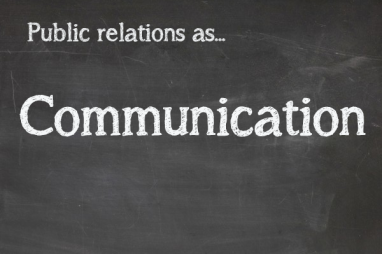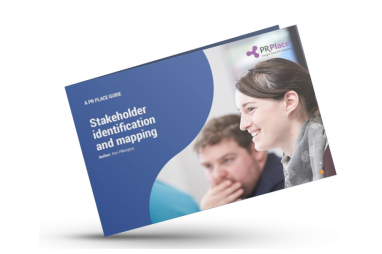Public relations as relationship management

About the author
Richard Bailey Hon FCIPR is editor of PR Academy's PR Place Insights. He teaches and assesses undergraduate, postgraduate and professional students.

Note: This article was first published on 22 February 2018 and updated with new information on 19 October 2023. This is one of a series of introductory essays to provide students and practitioners with an overview of schools of thought in this field.
It seems obvious that a discipline called public relations should be focused on relationships.
As a well-known definition from a classic public relations textbook puts it:
‘Public relations is the management function that establishes and maintains mutually beneficial relationships between an organization and the publics on whom its success or failure depends.’
This definition – from Cutlip, Center and Broom’s Effective Public Relations, first published in 1952 and still in print in its eleventh (international) edition – presents public relations management as relationship management. What’s more, the definition explains why this should matter: an organisation’s survival depends on these relationships.
There’s a body of relationship management theory and scholarship, centred around the work of John Ledingham and Stephen Bruning, arguing for public relations to be understood as relationship management.
Marketing understands that organisations depend on relationships with customers. No customers, no business. But public relations must also consider non-market groups such as regulators, politicians, activists, investors, trades unions and employees (collectively, citizens).
Publics, stakeholders, constituencies, communities
If relationships are central to public relations management, then it also follows that ‘public’ should mean something more specific than ‘the general public’. Relationships are with individuals and groups of people.
James Grunig (with Todd Hunt in 1984 and with Fred Repper in 1992) argued that publics were more dynamic than stakeholders, as they come together when facing a particular issue and deciding to become active on this issue (originally presented as ‘the situational theory of publics’).
Some scholars continue to argue for the distinction between publics and stakeholders, just as some continue to argue for the discipline to be called ‘public relations’ rather than ‘communication’ or ‘stakeholder relationship management.’ The whole first section of Public Relations Theory III published in 2023 is called ‘Publics Take Center Stage’.
Co-editor Carl Botan notes the shift from an ‘instrumental’ view of publics – in which they exist in a passive state waiting to be persuaded or even manipulated by organisations – towards a recognition that publics have agency. This shift matches the change from a broadcast approach to communication that prevailed in the mass media age to different approaches in the age of digital and social media.
Yet from the 1990s onwards, the use of stakeholders has tended to replace that of publics, certainly among practitioners. It’s a flexible term that allows many different approaches to identifying, segmenting and managing stakeholder groups.
We have provided a downloadable Guide to stakeholder identification and mapping, so won’t cover the same ground here.
There are some critical voices, though.
Stakeholder maps tend to depict a static relationship and risk assuming that all those within certain groups (eg shareholders) have the same interests and the same level of involvement in the organisation.
The focus is on organisation-public relationships, and this tends to assume that the relationship is as important to stakeholders as it is to the organisation. This is rarely the case, as this example shows.
Millions of us are members of the National Trust, a conservation charity. All will be happy to contribute to preserving beautiful places. Most members take advantage of the ‘free’ admission to country houses and landscape parks and may welcome (and even read) the member magazine. Only some will exercise their voting rights at annual general meetings; fewer yet will volunteer their time to support the work of the charity.
Despite paying for membership, this does not guarantee loyalty. Those with a keen interest in heritage and conservation may well be members of other bodies that may feel themselves to be in competition with the National Trust for funds, for members and for attention.
Maps of stakeholder relationships tend to place the organisation at the centre, rather like the medieval Christian view of the universe revolving around the earth. Yet as my National Trust example shows, most of us do not have undivided attention or fixed loyalties.
A more accurate view would present the organisation as one planet revolving around the sun, which is in turn just one star among many others in the galaxy. It’s a much more complex map.
In reconceptualising public relations in this direction, US scholars Timothy Coombs and Sherry Holladay prefer the word ‘constituencies’ to ‘stakeholders’ or ‘publics’. Their definition:
‘Public relations is the management of mutually influential relationships within a web of constituency relationships.’
It’s still centred on relationships, though these are now ‘mutually influential’ rather than ‘mutually beneficial’. The ‘web of constituency relationships’ reminds us that we may be at times be influenced by the organisation, but we are also open to influence from other sources. This is a very different model to the usual focus on organisation-public relationships.
Others extend this thinking and see public relations as community management. This sounds like a contemporary view, as community management is now assumed to mean social media management. Yet US scholars Kenneth Starck and Dean Kruckeberg have long argued for public relations to be seen as ‘an active attempt to restore and maintain a sense of community.’
This argument was made in 1998 – that’s before the web and long before social media. By community they mean society, and they later argued: ‘We believe that corporations ultimately exist by consent of society, which remains in fact the ultimate stakeholder of such corporations to which these organizations are answerable.’
Today, community and PR management is a distinct area of practice. Some see it as part of public relations (or even as the future of public relations). Others, such as Richard Millington, argue that it’s a distinct practice driven by the needs of the community members, not the needs of an organisation.
Media relations
Few could argue that media relations sits within the domain of public relations. Indeed, for much of the last century, it was the discipline most readily associated with the practice.
It also involves relationships. Journalists and editors are interested parties, but they do not have a straightforward commercial stake in an organisation. They cannot be ‘sold to’ like customers.
Instead, they can be seen as community stakeholders whose interest in the organisation is connected to the news value of that organisation in its sector or community.
Public relations practitioners use news to inform key publics and to present the organisation in a favourable light. Journalists are motivated to report news, but are under no obligation to report favourably. Indeed, news values dictate that most stories involve bad news rather than good news (a quick scan of the day’s headlines will confirm this).
So public relations practioners and journalists share an interest in news and do have a mutual dependency. But their perspective on the news can vary, creating a tension in the relationship.
And that’s assuming that a respectful relationship already exists. The problem more junior practitioners face is establishing relationships with journalists in an age when most conversations happen via email or social media, and when media databases make mass targeting so easy. The problem is compounded by the hollowing out of newsrooms, meaning that fewer journalists are targeted by ever more ‘pitches’ from a growing army of public relations practitioners.
For a journalist, there are two stark options: to become increasinly curt and hard to contact; or to join this army of public relations practitioners, vowing to be a better practitioner.
For the public relations practitioner, there are more options. News can be taken direct to the public via websites and social media channels bypassing traditional media channels (a process described as disintermediation), or via a growing army of influencers who may not share the cynicism of the professional media towards public relations.
Influence
Coombs and Holladay talk about ‘mutually influential relationships’. Robert Cialdini has written that rare thing, an academic bestseller, exploring what’s involved in influence. He identifies six paths to influence:
- Reciprocity: If you do something for someone, they’re more likely to do something for you
- Consistency: People act in ways that are consistent with what you have said or done previously
- Liking: If people like you, they are more likely to do what you want
- Authority: If people see you as an authority figure, they’re more likely to do what you say
- Social proof: People do what they see other people doing
- Scarcity: People don’t like losing the opportunity to get something
Within the public relations literature, practitioner Philip Sheldrake has written about influence. In The Business of Influence, he provides a critique of Grunig’s two-way symmetric ideal on the grounds that there are only two influence flows involved: the organisation’s influence with its publics, and the publics’ influence on the organisation – described earlier as organisation-public relationships. (Grunig would surely argue that these are the only two we can claim to manage.)
A former engineer, Sheldrake had identified six influence flows, meaning that four were beyond the control of public relations.

Today, influencer marketing is a growth area as public relations teams seek to supplement – or even replace – media relations with influencer relations. This specifically refers to those with niche followings on social media channels such as YouTube and Instagram. Though an influencer could also be an established figure in public life, and not necessarily someone with a large social media following.
Social capital and public relations
The concept of social capital is useful for explaining relationship management. Some groups have a financial stake in the organisation: most obviously investors, customers and employees. But many others have non-financial stakes.
As Norwegian scholar Oyvind Ihlen explains it: ‘Social capital is seen as a result of a conscious or unconscious investment strategy that involves exchanges of, for instance, gifts, services, words, time, attention, care or concern. It also implies “obligations” or “credit”.’
These exchanges are not as crude as a form of hush money, but public relations practitioners hope that by having built up trust (social capital), stakeholders will at least give them an opportunity to explain their position when the organisation faces scrutiny and criticism.
In an ideal world, these groups would provide a first line of defence by speaking up in support of an organisation when it’s under attack in a public forum like the press or social media. Stephen Waddington and Steve Earl wrote about this first line of defence in #BrandVandals.
Finnish scholar Vilma Luoma-aho defines social capital as ‘the extent of the resources available to an organization through networks of trust and reciprosity among its stakeholders.’
So the outcome of relationship management is a form of intangible capital built on trust and reciprosity.
She writes: ‘public relations practitioners should be seen as creators and maintainers of organizational social capital’ and argues that social capital is the way to connect relationships, trust and reputation into one conceptual framework.
But how do we measure relationships?
This sounds rational. It sounds manageable. But is it measurable?
A challenge to the relational view of public relations is the need to measure the value of these intangible relationships in order to demonstrate progress, prove effectiveness and deliver value.
James Grunig and Linda Hon published an IPR paper addressing this challenge.
Having asserted that the value of public relations is in relationships, they provided an analysis of the six factors that can be assessed within relationships:
- Control mutuality (the extent to which the relationship is two-way)
- Trust (can the organisation be relied on to keep its promises?)
- Commitment (long-term orientation)
- Satisfaction (do the benefits of the relationship outweigh its costs?)
- Exchange relationships (the extent to which gains are expected from the relationship)
- Communal relationships (is there concern for the welfare of the other?)
Measurement specialist Katie Paine has followed in Grunig’s footsteps, arguing:
“The future of public relations lies in the development of relationships, and the future of measurement lies in the accurate analysis of those relationships. Counting impressions will become increasingly irrelevant while measuring relationships and reputation will become ever more important.”
PR Place essays
Communication, reputation and relationships are not mutually-exclusive, though they are distinctive paradigms* each with their own literature and scholars championing each perspective. Nor do professional and member associations all agree. IABC and IoIC both champion ‘communication’ in their names; CIPR and PRSA both name check ‘public relations’. The PRCA has a foot in both camps as its name has, since 2016, stood for Public Relations and Communications Association. No major association has built ‘reputation’ into its name (there is no Association for Reputation Managers, ARM, or Association for Crisis, Risk and Reputation Management).
* Note to students. Here’s a simple way to understand what’s meant by a paradigm. If a definition starts with ‘public relations is…’ then a paradigm starts with ‘public relations as…’ It’s a way of seeing, a worldview.
You can read more on different perspectives on public relations in the following essays in this series:
Public relations as reputation management
Public relations as communication management
Further reading
Botan, C and Sommerfeldt, E (editors) (2023) Public Relations Theory III: In the Age of Publics, Routledge
Broom, G and Sha, B (2013) Cutlip and Center’s Effective Public Relations (11th edition), Pearson
Cialdini, R (2007) Influence: The Psychology of Persuasion, Collins Business
Coombs, WT and Holladay, S (2010) PR Strategy and Application: Managing Influence, Wiley-Blackwell
Grunig, J and Hunt, T (1984) Managing Public Relations, Holt, Rinehart and Winston
Grunig, J and Repper, F (1992) Strategic Management, Publics and Issues in Grunig, J (ed) Excellence in Public Relations and Communication Management, Lawrence Erlbaum
Hon, L and Grunig, J (1999) Guidelines for Measuring Relationships in Public Relations, IPR (pdf)
Ihlen, O (2009) On Bourdieu: Public Relations in Field Struggles in Ihlen, O, van Ruler, B and Fredriksson, M Public Relations and Social Theory: Key Figures and Concepts, Routledge
Kruckeberg, D and Starck, K (1988) Public Relations and Community: A Reconstructed Theory, Praeger
Ledingham, J and Bruning, S (eds) (2000) Relationship Management: A relational approach to public relations, Lawrence Erlbaum
Ledingham, J and Brunig, S (1998) Relationship Management in Public Relations: Dimensions of an Organization-Public Relationship in Public Relations Review 24(1) 55-65
Luoma-aho, V (2009) On Putnam in Ihlen et al Public Relations and Social Theory: Key Figures and Concepts, Routledge
Millington, R (2012) Buzzing Communities: How to Build Bigger, Better, and More Active Communities, FeverBee
Paine, K (2011) Measure What Matters: Online Tools for Understanding Customers, Social Media, Engagement, and Key Relationships, Wiley
Sheldrake, P (2011) The Business of Influence: Reframing Marketing and PR for the Digital Age, Wiley
Waddington, S and Earl, S (2013) #BrandVandals: Reputation wreckers and how to build better defences, Bloomsbury


